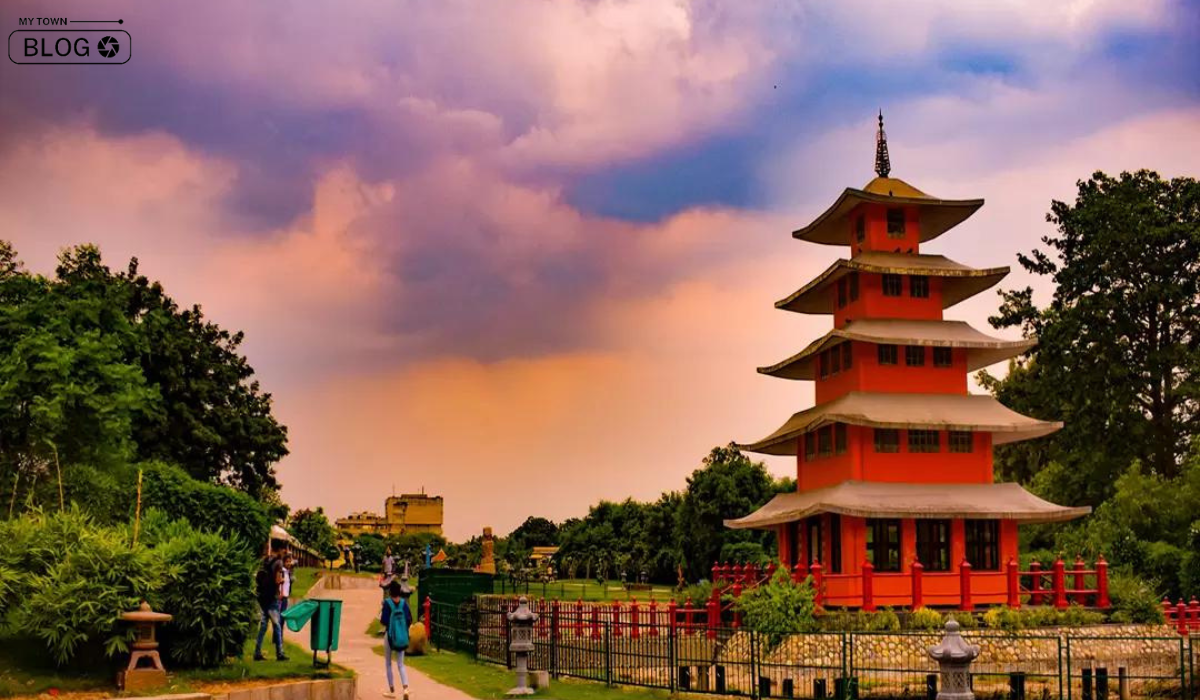The Indian Government established the Japanese Garden Chandigarh, situated in Sector 31 of the union territory of Chandigarh, across 13 acres of land in 2014. Shivraj Patil officially opened it on November 7, 2014. Boasting water bodies, pagoda towers, waterfalls, a meditation center, a Buddha idol, and golden bamboo, it stands as Chandigarh’s inaugural garden infused with a Japanese aesthetic. The development of this unique space costs Rs 6 crore.
Phase 1 was inaugurated on November 7, 2014, and Phase 2 opened to the public on June 4, 2016, marking successive stages. An underground tunnel, adorned with exquisite Japanese paintings on each side, connects both phases. Crafters meticulously use Japanese architecture to craft the garden, infusing each element with a distinctive Japanese essence.
Pagoda Tower:
The Japanese pagoda finds its roots in the Indian stupa, a dome-shaped monument originally designed to house relics and sacred writings of revered Buddhist figures. Traditionally, pagodas have an odd number of stories, and their square shape symbolizes the earth. Each level of the pagoda is dedicated to one of the five elements: wind, water, earth, fire, and sky. The primary purpose of a Japanese pagoda was to serve as a repository for Buddhist relics and sacred writings.
In the context of Buddhist elements in Han art, an article by Wu Hung suggests that the incorporation of Buddhist iconography into native Chinese traditions was so seamless that it led to the development of a unique system of symbolism. This blending of cultural influences is evident in the design and symbolism of Japanese pagodas, reflecting a rich tapestry of spiritual and artistic heritage.
The Japanese Zen Garden:
The Japanese rock garden, or Karesansui, a dry landscape known as a Zen garden, is an artful creation, forming a stylized miniature landscape. It meticulously arranges rocks, water features, moss, pruned trees, and bushes in a carefully composed manner. Gravel or sand is often raked to simulate the appearance of ripples in water.
Crafters intentionally design a Zen garden, surrounding it with a wall and making it of modest size, to be admired from a singular seated perspective outside its boundaries. Often, the viewpoint is a porch, like the one at Hojo, the chief monk’s residence in a temple or monastery. Classical Zen gardens originated in Kyoto’s Zen Buddhist temples during the Muromachi period, providing tranquil spaces for meditation and reflection.
Crafters created these gardens to capture nature’s intimate essence, prioritizing authenticity over exact replication, evoking a genuine connection with nature. They were conceived as aids to meditation, encouraging contemplation on the true meaning of life. Essentially, Japanese rock gardens serve as serene spaces, fostering reflection and a connection with nature’s profound simplicity, offering tranquility.
The classic Japanese gate:
The entry gate to the Phase-1 rock garden is a traditional structure known as a “Torii.” Japanese architecture typically situates this distinctive gate, a customary element, at the entrance of shrines. The fundamental role of the “torii” is to signify the entrance to a sacred and revered space. Its presence not only marks the threshold of the rock garden but also symbolizes the transition into an area of spiritual significance, emphasizing the sacred nature of the surroundings.
The statue of Buddha:
Within the Japanese rock garden, the arrangement of rocks takes on symbolic meanings. Some rocks represent mountains, with a particular emphasis on Horai, the legendary residence of the Eight Immortals in Buddhist mythology. Craftsmen commonly interpret other rocks as boats or living creatures, often resembling turtles or carp. Arranged rocks in a Japanese garden form a visual waterfall, skillfully conveying a message through composition, enhancing its beauty with precision. In Sakutei-ki, craftsmen thoughtfully consider the arrangement of rocks in the garden to convey deeper meanings and evoke a sense of natural beauty, aligning with this concept. Versatile Japanese garden rocks enhance aesthetics, conveying symbolic messages inspired by nature and Buddhist mythology, adding meaningful expressions to the garden.
The symbol of Yin and Yang:
In Chinese philosophy, the concept of yin and yang (陰陽 yīnyáng, translated as “dark-bright” or “negative-positive”) elucidates the idea that seemingly opposing or contradictory forces are, in reality, complementary, interconnected, and interdependent in the natural world. This philosophy suggests forces coexist and give rise to each other. Tangible dualities like light, dark, fire, water, or expanding, and contracting represent yin and yang’s inherent duality. The duality encapsulated in yin and yang is foundational to numerous branches of classical Chinese science and philosophy.
In traditional Chinese medicine, practitioners aim for a balance between forces for optimal health, with this equilibrium serving as a guiding principle. In Chinese martial arts, yin and yang play a central role, influencing practices like baguazhang, taijiquan (t’ai chi), and qigong (Chi Kung).l The I Ching prominently features the concept, serving as a fundamental aspect of divination and philosophical contemplation. Yin and yang symbolize a dynamic interplay crucial for comprehending the inherent harmony and balance within the natural order. Essential insights.
The dragon in Japanese tradition:
In Japanese folklore, a mythical creature deeply rooted is the Japanese dragon, referred to as ryū or tatsu (龍 or 竜, meaning “dragon”).
Similar to other creatures deemed dragons, the Ryū is a majestic, fantastical being, closely resembling a serpent in its appearance.
Sharing lineage with the Chinese lóng and the Korean yong, it symbolizes power and wisdom, often linked with natural elements. The Japanese dragon, a captivating figure in cultural narratives, frequently appears in art, literature, and traditional folklore, embodying mythical symbolism.
An exquisite sculpture featuring a woman with a cameraman:
A professional photographer skillfully captures a beautiful woman in this captivating sculpture. It serves as a striking representation, highlighting a profound comparison between a woman’s elegance and the vast beauty of nature. In this context, it underscores the unique ability of a woman to embody the essence of nature itself.
In our vast world, women possess extraordinary qualities, seamlessly blending with nature’s awe-inspiring elements, creating harmonious unity and beauty. This juxtaposition prompts contemplation on the intrinsic connection between femininity and nature, celebrating the harmonious union of grace and environment.
Meiso Koya Hut for Meditation:
MEISO KOYA in the Japanese garden has consistently served as a haven for inner peace and serenity.
Crafters intentionally shape a sacred space, providing refuge for spiritual solace, and inviting individuals to sit quietly, calm their minds, and discover tranquility. MEISO KOYA aligns with Chandigarh’s Japanese garden tradition, offering a contemplative environment for visitors to find solace and inner calmness.
Bamboo trees:
The craftsmen meticulously craft the trees in the Japanese garden in Chandigarh, exhibiting thoughtful design. The lush green landscapes, adorned with the elegance of golden bamboo trees, contribute to the natural beauty of the surroundings.
The garden highlights pagoda-shaped lamps and chairs, intricately designed to embody Japanese culture, enriching the ambiance with cultural authenticity.
Crafters meticulously shape elements, transcending functionality to embody Japanese design’s aesthetic principles and cultural nuances, crafting a rich, meaningful landscape. Landscaping, lighting, and seating details enhance the experience, creating a harmonious blend of nature and cultural aesthetics in the garden.
Operating hours:
The park welcomes visitors every day from 6 AM to 10 PM.
For the best experience, explore the garden in the early morning to fully appreciate its serene beauty and tranquil atmosphere.
Travel tips:
To enhance your visit, ensure you have your camera on hand to capture the beauty of the surroundings. Remember to carry a valid photo ID card for identification purposes. For convenience, bring along a small bag to carry your essential items. Additionally, it’s advisable to carry a water bottle to stay hydrated during your time in the park.
Also Read: Morni Hills: The Best Place To Visit In Summer
FAQs:
Are there any entry fees for the Japanese Garden Japanese garden Chandigarh?
No, the park is free to enter.
Can I bring food into the park?
Visitors must refrain from bringing outside food; however, designated picnic areas are available for their convenience.
Is the park wheelchair accessible?
Yes, the Japanese Garden is wheelchair-friendly.
Are guided tours available?
Guided tours may be available; checking with the park authorities for current information is advisable.
Are any cultural events or festivals held at the Japanese Garden Japanese Garden Chandigarh?
The park occasionally organizes cultural events and festivals, and we encourage visitors to check the schedule for updates.








